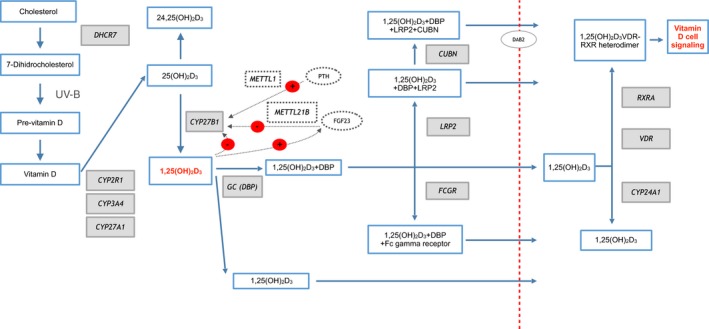Figure 1.

Vitamin D pathway. 7‐DHC follows a two‐stage reaction involving ultraviolet‐B irradiation and thermal isomerization. Vitamin D is converted into 25‐hydroxyvitamin D3 (25[OH]D3) by a hydroxylation mechanism mediated by vitamin D 25 hydroxylase. Subsequently, 1α‐hydroxylase, regulated by PTH and FGF23, transforms 25(OH)D3 into its active form, 1,25‐dihydroxyvitamin D3 (1,25[OH]2D3). The proteins 25(OH)D3 and 1,25 (OH)2D3 mainly circulate bound to carrier proteins (DBP), but a small fraction circulates freely or bound to albumin. The internalization mechanism is produced mainly by DBP‐megalin (LRP2). However, in some cells this process can occur by binding to other proteins and even by passive diffusion. Finally, 1,25(OH)2D3binds to the VDR nuclear receptor, interacting with the RXRA, forming a heterodimer that allows transport to the cell nucleus. Genes involved in the vitamin D pathway are shown in grey. The regulatory pathway of the gene CYP27B1 (METTL1, METTL21B, FGF23, PTH) is represented with a dotted line. Endocytosis of the complex formed by LRP2 and CUBN requires DAB2, represented in the figure within a light grey circle. The mechanism of VD binding to the PDIA3 receptor is not included in the figure
